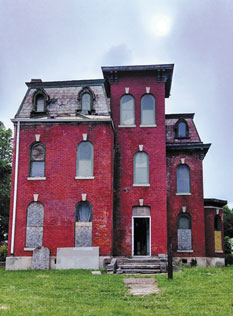Each day a multitude of vehicles pass by a 140 year old landmark on the southwest corner of South Emerson Avenue and Brookville Road. Once a grand Second Empire style house, today the Horner House stands as a poor shadow of its former glories.
Abraham Horner, an Ohio Buckeye and a Civil War veteran of Indiana’s Minute Men who rallied to repel Confederate General John Hunt Morgan’s invasion of southern Indiana, was a druggist on the south side of Indianapolis when he chose Lot 1 in Downey & Brouse’s Addition to Irvington in 1875 to have his home built so that his daughter Rose would be close to the Irvington campus of Butler University. Horner probably had New Albany, Indiana architect George B. F. Cooper design the house and then engaged New Albany contractors John F. and Henry M. Cooper to build the house for $4,000 (2014: $85,011.95). Unfortunately, the economic crisis of the late ‘70s caused Horner to lose his “pleasant home” shortly after it was finished.
The Horner House was one of several “towered” houses to be built in the southwest part of Irvington. In a time before motorized trolley cars, English Avenue, unlike the National Road, offered a gentle grade out of Indianapolis to the Classic Suburb for the mule car to careen along the Irvington Stratford & Indianapolis Street Railway. Many thought the “gateway” into Irvington would be along this route and wanted their fine homes to be near it.
For the remainder of the nineteenth century, the Horner House passed through several owners, most of whom did not live in the house. One of the resident owners in the late 1880s was a prosperous Franklin Township farmer, James Lee Thompson. A veteran of the Civil War, Thompson bought this house shortly after being elected a Marion County Commissioner in November 1886. Previously he had been elected Franklin Township trustee and later served in the Indiana House of Representatives.
The twentieth century ushered in the beginning of four decades of stability for the Horner House under the Fleece and Terrill families. Silas Franklin “Frank” Fleece bought this Irvington house in the spring of 1900. A native of the Hendricks County, Indiana community of North Salem, he worked in the hardware business before becoming the state agent for the Grand Detour Plow Co. Initially, 410 S. Emerson Avenue was the family home to Fleece and his wife Frances along with their two teenage daughters Letha and Alta and young son, Verner. The end of the century’s first decade saw changes in the Fleece household; the daughters had married and Silas had opened a new business, S. F. Fleece Lighting Co., which specialized in gas lighting and gas stoves for country homes. However, Fleece soon returned to his original business interest, opening a hardware store on the east side and becoming the local distributor of Little Wonder Oil Stoves.
The 1920s and thirties saw George C. and Mary A. Terrill making the Horner House their family home. An adult daughter, Fay Terrill, also lived with them. Terrill was superintendent of Ripley County public schools when he was appointed Indiana state insurance securities deputy in 1910. He continued his work with the state in 1916 when he became a field examiner with the state board of accounts. While the Terrills were residing in the Horner House, it was featured in an Indianapolis Star series on unique Indianapolis houses. Titled “Old Houses With Towers Examples of Dignified Style of Architecture,” the article noted, “The windows show an odd capstone or keystone as their only ornament, except that those in the mansard (roof) are surrounded by a restrained casing or ‘reveal.’” The “simple, but attractive” cast iron crestings also mentioned are long gone. George Terrill died in 1933 and Mary Terrill died seven years later.
After World War II, Irvington VFW Post 7403 briefly occupied the Horner House before it was divided into five to seven apartments. This multi-resident use continued through the 1950s until subsequent owners turned the house into two living units. During this time, the house lost a number of architectural features, including the mansard roof section of the tower.
After years of neglect close to the point of no return, Indiana Landmarks took ownership of the Horner House in 2011 and then sold it to Eric and Amanda Browning who began giving this landmark the loving care it has long deserved in the fall of that year. Although the recovery has been painstakingly slow, progress is being made. You can read more about the Horner House and follow future developments at hornerhouseindy.blogspot.com.



